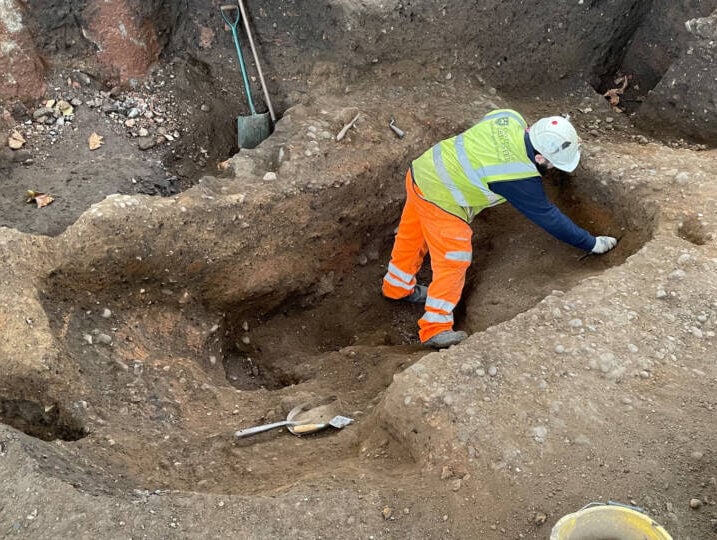The 20-foot-deep burial pit holds 123 bodies, and experts are baffled as to how so many people died in such a short amount of time.

Mathew Morris/ULASArchaeologists carry out excavations at Leicester Cathedral.
Leicester Cathedral, an English church with a history stretching back hundreds of years, has become the focus of a groundbreaking archaeological discovery first made in 2022.
While excavating the cathedral’s gardens for the future construction of a learning center, archaeologists came across a 12th-century burial pit containing the remains of 123 people. Experts initially suspected they were victims of the Black Death, but radiocarbon dating revealed the burials predate the disease by nearly 150 years. Now, researchers are questioning what caused such a sudden mass casualty event.
The 800-Year-Old Burial Pit At Leicester Cathedral
In 2012, the body of King Richard III was found buried under a parking lot in Leicester, and his remains were reinterred in Leicester Cathedral three years later. Visitors from all over the world began flocking to the central English town to visit the monarch’s new tomb.
To keep up with the influx of guests, officials approved plans to build a heritage learning center in the cathedral’s gardens. Archaeologists were brought in to excavate the site ahead of construction — and they uncovered a trove of historical artifacts.
However, their most striking discovery was a 20-foot-deep burial pit filled with the remains of 123 men, women, and children.
At first, experts assumed these remains belonged to victims of the Black Death, because the bones showed no evidence of violence. Then, radiocarbon dating revealed the bodies were from the 12th century, about 150 years before the bubonic plague killed up to half of Europe’s population.

Mathew Morris/ULASArchaeologists sort through human remains discovered in the medieval burial pit.
“That was surprising,” Mathew Morris, project officer at Leicester University’s archaeological services, told The Guardian. “We have no idea, at present, what might have triggered such a massive cause of death. As far as we know, the bubonic plague did not reach our shores until 1348. So what was the cause of the mass deaths that occurred then?”
The remains were seemingly dumped into the vertical shaft in rapid succession. “It looks as if successive cartloads of bodies were brought to the shaft and then dropped into it, one load on top of another in a very short space of time,” said Morris. “In terms of numbers, the people put in there probably represented about 5 percent of the town’s population.”
However, the bodies had also been prepared for burial, meaning they hadn’t been immediately rushed to the pit to prevent the spread of illness. “There was also no evidence of clothing on any of the bodies — no buckles, brooches, nothing to suggest these were people who were dropping dead in the street before being collected and dumped,” said Morris. “In fact, there are signs that their limbs were still together, which suggests they were wrapped in shrouds. So their families were able to prepare these bodies for burial before someone from a central authority collected them to take to the pit burial.”
Scientists are currently studying the bodies for signs of viruses, bacteria, or parasites that could have caused such a high number of deaths in a short amount of time. But until the results come in, archaeologists are busying themselves studying the countless other artifacts they’ve recovered from Leicester Cathedral.
What Other Artifacts Were Found On The Grounds Of Leicester Cathedral?
While the most curious finding from the Leicester excavations is undoubtedly the burial pit, archaeologists also uncovered a wealth of objects that are helping them piece together the church’s long history. In total, the team found nearly 20,000 artifacts as well as 1,237 graves ranging from the 11th century to the 1800s.
“It’s a continuous sequence of 850 years of burials from a single population from a single place, and you don’t get that very often,” Morris stated. “It has generated an enormous amount of archaeology.”

Mathew Morris/ULASThe remains of a possible Anglo-Saxon building discovered at the site.
Beneath the graves, archaeologists uncovered the remnants of Anglo-Saxon dwellings and even a Roman shrine. Overall, the excavations at Leicester Cathedral have provided archaeologists with an invaluable glimpse into the history of central England.
From the discovery of one of the largest mass burial pits in the country to a penny dating back to the ninth century C.E., their findings are shedding light on the history of life, death, and religious ceremony in medieval England.
After reading about the mass burial pit discovered at Leicester Cathedral, go inside the true story of Humpty Dumpty, the famous English nursery rhyme. Then, learn about another 12th-century English tale, the curious case of the Green Children of Woolpit.





